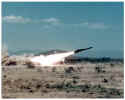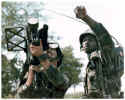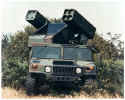1984
FY 84 The U.S. Army Environmental Hygiene Agency completed a year long study (begun in May 83) of air quality at Redstone Arsenal. The study's results indicated a very good air quality with influences from distant locations off post.
FY 84 A team of AML scientists developed and flight demonstrated a major advancement in direct-fire missile guidance technology. The improved missile guidance used a CO2 laser as a critical element of a new laser beamrider guidance link.
FY 84 MICOM approved right-of-way land requirements requested by the State of Alabama Highway Department for construction of I-565. The total acreage to be transferred involved 350 acres along the arsenal's northern boundary. The installation's total land area was reduced from 38,248 to 37,898 acres.
FY 84 About 5000 local plaintiffs filed a federal lawsuit seeking $1.2 billion in damages from the Olin Chemical Corporation and the Tennessee Valley Authority (TVA) for allegedly conspiring to hide the DDT pollution problem on Redstone Arsenal from the public. Also named in the suit were two former managers of Olin's DDT plant on the installation.
FY 84 Sunohio, a firm from Canton, Ohio, began a $375,000 project to chemically remove PCBs from electrical transformers on the arsenal.
FY 84 The 3d Battalion, 68th ADA, Fort Bragg, North Carolina, became the first Army HAWK unit to deploy by ship as part of an XVIII Airborne Corps emergency deployment exercise. The HAWK equipment proved durable and the unit was able to become operational in minimum time.

FY 84 OSD granted an exception to the National Disclosure Policy to allow the HELLFIRE to be adapted to meet Swedish coastal defense needs. Sweden initiated a lease agreement for GLLD equipment as part of a feasibility study of coastal defense using the HELLFIRE system.
FY 84 The first delivery of STINGER missiles to the National Guard went to the 5th Battalion ROLAND of the 20th ADA at White Sands, New Mexico.
FY 84 Initial delivery of STINGER training and support equipment to the U.S. Air Force (USAF) was made during the year. This equipment went to Korea. The Air Force planned to deploy STINGER with little or no duplication of Army efforts.

FY 84 The LANCE system was extended through 1990. Ground support equipment and other changes were made to support the extension of the missile's shelf life.
January 84 The first winners of the Holger N. Toftoy awards for the best and most improved air defense and land combat systems readiness were announced this month. The award was named in honor of the late MG Holger N. Toftoy, a leader in the early Army missile programs at Redstone Arsenal who helped bring the Von Braun team from Germany after World War II. MSRD conceived the award as a way to promote competition among missile units and provide a means to recognize the outstanding one, thereby improving readiness conditions.

5 January 84 After Army intelligence data continued to reinforce the threat assessment justifying development of the STINGER-RMP, the Under Secretary of the Army directed that the RMP engineering development program be initiated. He also agreed to justify the reprogramming of funds with the House Armed Services Committee, which did not accept the threat assessment and believed the RMP to be a high technical risk.
23 January 84 The MICOM Parts Acquisition Program Office was established in keeping with directions contained in DARS-6 and additional DARCOM guidance.
February 84 The SHILLELAGH system was phased out of the U.S. Army National Guard (ARNG). Arkansas was the last ARNG unit to have the system. The only active Army SHILLELAGH units were located at Fort Bragg, North Carolina.
February 84 Following multipurpose submunition (MPSM) rocket firing demonstrations, the U.S. Marine Corps (USMC) Development and Education Center, Quantico, Virginia, drafted a ROC document to adopt virtually all HYDRA 70 rocket capabilities for USMC attack helicopter operations.
February 84 The plan for transferring HAWK to ARNG was developed during a conference at MICOM.
14 February 84 The first sale of the PATRIOT missile system to a foreign government occurred when the Netherlands accepted two FMS cases to purchase the system.
March 84 MICOM awarded the Kearfott Division of the Singer Company an $18.4 million contract for development of system hardware, software, and integrated logistics support for the Module I phase of the SHORAD C2, which was being designed to improve the flow of battle management information at the divisional level.
March 84 Japan became the first FMS customer to receive the STINGER missile for tactical use.
March 84 MICOM awarded General Dynamics a contract for the last buy of Basic STINGER missiles for U.S. forces.
March 84 The German government sent European industry a request for proposal for production of the STINGER weapon system in Europe. Initial analysis of the proposals submitted by Messerschmitt Boelkow Blohm/Bodenseewerk Geratetechnik and Dornier/Diehl indicated that production in Europe was feasible.
March 84 After DARCOM approved the ATAS engineering development acquisition, contract negotiations began during this month. Before year's end, the U.S. Army Aviation Systems Command (AVSCOM), overall manager for the MLMS weapon subsystem, signed contracts with General Dynamics and Bell Helicopter Textron, Incorporated, for full-scale development of the ATAS.
6 March 84 During the first New Mexico ARNG CHAPARRAL training firing at Fort Bliss, Texas, the missile scored a direct hit.
1 April 84 The Federal Acquisition Regulation (FAR) standardized under one regulation the way federal agencies would buy or lease items, replacing a maze of agency regulations used in procurement.
2 April 84 The MICOM DCG for Procurement and Readiness assigned responsibility to PAD for implementing Section 794 of the 1984 Appropriations Act, in which Congress required that a warranty be obtained with certain weapon system production contracts.
21 April 84 Hughes Aircraft received a contract for very high speed integrated circuit (VHSIC) exploratory development leading to the insertion of a wireless command link (WCL) in the TOW system.
23 April 84 MICOM established the System Engineering and Production Directorate (SEPD) as a POE to increase emphasis on overall systems engineering and production engineering. It would also enhance the command's ability to successfully transition weapon systems from research and development to production. These functions had formerly been part of the U.S. Army Materiel Command (AMC).
23 April 84 MICOM established the Battlefield Automation Management Directorate (BAMD) to address the Army's recognized need for a unified software support concept for fielded battlefield automated systems.
May 84 The M22 missile subsystem was phased out of the Regular Army inventory, although 12 state National Guard units continued to use the system for training purposes.

17 to 19 May 84 Three demonstration firings of the AVENGER system at Yakima Firing Range, Washington, resulted in two direct hits and one tactical hit on a ballistic aerial target system. In these initial evaluations, the AVENGER met or exceeded performance requirements specified in a Quick Reaction Plan which called for a pedestal-mounted STINGER system as a one-for-one replacement for half of the 9th ID's manportable air defense system (MANPADS) teams.

25 May 84 A sole source letter contract for the M72E4 PIP was awarded to a consortium headed by Talley Defense Systems because of its involvement in the M72 LAW production and improvement effort. The consortium was considered to have a unique capability in building and providing test hardware that could reduce the schedule risk of the PIP effort. The contract was definitized on 21 September 84.
June 84 Fielding of MLRS to the 2d ID in Korea was completed, representing the largest single increase in raw firepower for the Eighth U.S. Army (EUSA) in almost 5 years.
1 June 84 Olin Chemical Corporation (the former manufacturer of DDT on Redstone Arsenal) made public its proposed plan for remedying the DDT pollution problem on the installation. The company proposed to bypass and isolate in place the most heavily contaminated area by rerouting Huntsville Spring Branch. A 100-foot dam would be built to divert water from the contaminated area to an existing loop that would be deepened and widened. Three-fourths of the way through the loop another dam would be constructed to route the flow of the water to a new channel that would be dug through existing land masses back to the Huntsville Spring Branch, about 2 miles below the contaminated area. The company also planned to build two more dams on the lower portion of the bypassed channel as well as to fill in more than a mile of the original streambed. Olin estimated that this project would cost about $20 million and take about 4 years to complete.
13 June 84 The Under Secretary of the Army directed DA to obtain the reprogramming of necessary funds and start the RMP program as soon as possible.
1 July 84 Work on a possible RASA reduction-in-force (RIF) ceased after no final decision was made on whether certain installation support functions would be contracted out. Unfortunately, the activity still experienced many personnel and morale problems as well as a degrading of the general mission because of a December 83 hiring freeze, the possible RIF, and the potential contracting out of services.
July-August 84 By this time, there appeared to be a philosophical difference between DOD and DA as to the best approach to the SHORAD C2 program. It also became evident that there was a fundamental difference in the increment/building block approach envisioned by AMC, the developer, and TRADOC.
August 84 The Japan Defense Agency approved the PATRIOT missile system as the replacement for its NIKE J.
28 August 84 The first joint firing of a HELLFIRE missile was conducted at Yuma Proving Ground. The crew of an OH-58D KIOWA WARRIOR located the target with the helicopter's laser and an AH-64A APACHE gunner fired a live warhead HELLFIRE missile, which hit directly on the target.
31 August 84 The review panel appointed by the court to monitor the DDT cleanup on Redstone Arsenal accepted Olin Chemical Corporation's proposed remedy, after the company agreed to extend the cleanup another 1.5 miles below the point where it had planned to stop work. The modified plan, which was expected to add substantially to the cleanup cost, would isolate and contain about 93 percent of the estimated 422 tons of DDT residue. The estimated completion date for this program was 1988, followed by 10 years of monitoring the remedial action to ensure that the levels of DDT in fish found in the contaminated streams dropped to the federal safe level of five parts per million or less.
September 84 The PATRIOT missile system was conditionally released for deployment in Europe.
September 84 The Air Force terminated its on-site participation in the JTACMS program at MICOM except in a liaison capacity.
September 84 The 1st Division, 200th ADA Battalion of the New Mexico ARNG became the first guard unit to receive the CHAPARRAL system as part of the Army's modification of air defense capabilities.
13 September 84 The MICOM Commander approved the reclassification of the CHAPARRAL FLIR from limited production to standard type.

14 September 84 PATRIOT completed Follow-on Evaluation (FOE) III ahead of schedule. The highly successful test program demonstrated the system's capability to meet its operational requirements with production hardware and operational troops.
20 September 84 A range dedication officially renamed F-Range to Corkern Range in honor of a former Redstone explosive ordnance disposal instructor killed during the Vietnam War. It was dedicated to Sp4 Jerry W. Corkern who was the first U.S. Army explosive ordnance disposal (EOD) technician killed in the war on 26 November 66.
20 September 84 Congress approved funds for the STINGER-RMP engineering development program, and a letter contract was issued to General Dynamics less than a week later.
October 84 MICOM supported the USAF in its demonstration of another mobile weapon system (MWS), consisting of an ATAS launcher and a 30mm GAU-13 cannon mounted on a light armored vehicle, by negotiating a lease agreement with General Dynamics for prototype ATAS launchers for use on the MWS. During the firing demonstration conducted at the end of the test, both of the STINGER missiles fired scored direct hits against unaugmented QH-50 drone helicopters.
October 84 Boeing submitted an unsolicited proposal for 51 AVENGERS to MICOM after the 9th ID successfully fired STINGER missiles from the unit in May 84.
October 84 The PATRIOT missile system was certified ready for European deployment.
October-December 84 A Marine Corps light antiaircraft missile battalion at Yuma Proving Ground (YPG), Arizona, demonstrated that the SPARROW/HAWK launcher could be set up, taken down, and moved faster than the conventional HAWK launchers. Non-firing tests in November and December 84 proved that a SPARROW missile mated to a HAWK guidance system could track a flying target.
9 October 84 The new SETTER system was displayed publicly for the first time. Developed jointly by MICOM and TACOM, the SETTER Light Air Defense system focused on existing Army missile technology. Consequently, a prototype of the system was completed in FY 84, less than a year after exploratory development had begun. The system would provide a fully autonomous SHORAD capability, meeting all user requirements with only a two-man crew.
17 October 84 AMC tasked MICOM with imposing human factors, manpower, personnel and training considerations on its development and acquisition programs to make equipment "soldier friendly." On 15 November 84, the MICOM Commander established a special task force on Manpower and Personnel Integration (MANPRINT), the primary task of which was to develop a command plan for implementing the AMC tasker.
November 84 PATRIOT equipment for the first European battalion was shipped this month and arrived in January 85.
November 84 The Deputy Secretary of Defense approved the Army's request to develop an interim version of the JTACMS to counter Warsaw Pact second echelon forces.
November 84 The Army and Air Force issued a joint statement on the need for conventional missile systems to engage targets in the deep battle area.
29 November 84 A cost-plus-incentive-fee contract for the cooperative development of the TGW was awarded to a consortium of companies consisting of the Martin Marietta Corporation of the United States; Thomson Brandt Armaments of France; Thorn EMI Electronics, Limited, of the United Kingdom; and Diehl GmbH and Company of Germany. The remaining participant was MDTT, Incorporated, a U.S. company with a fully integrated U.S.-European staff which acted as a management focal point for the joint venture.
23 December 84 The last two NIKE HERCULES firing units in USAREUR were inactivated. The only remaining active U.S. HERCULES assets were at Fort Bliss, Texas.
Redstone Arsenal Era:
Intro,
1980,
1981,
1982,
1983,
1984,
1985,
1986,
1987,
1988,
1989
